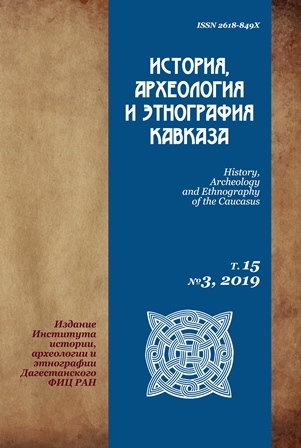ПЧЕЛОВОДСТВО У НАРОДОВ ДАГЕСТАНА В XIX – НАЧАЛЕ XX В.
- Авторы: Рамазанова З.Б.
- Выпуск: Том 15, № 3 (2019)
- Страницы: 485-494
- URL: https://caucasushistory.ru/2618-6772/article/view/1537
- DOI: https://doi.org/10.32653/CH153485-494
Аннотация
Статья посвящена исследованию одного из компонентов подсобных отраслей хозяйства народов Дагестана в XIX – начале XX в. – пчеловодству. Исследования исторически сложившихся систем жизнеобеспечения этносов представляются особенно актуальным в настоящее время, когда традиционные системы хозяйствования, в том числе и подсобные занятия народов Дагестана, подвергаются нивелировке и исчезают. Их изучение важно не только в развитии, связанном с радикальными изменениями в общественном и домашнем быте, но в этнокультурных взаимодействиях. Актуальность темы определяется наметившимся в последнее время повышенным интересом к истокам хозяйственно-культурных типов. Автор сделал особый акцент на изучении домашнего пчеловодства, которое сочеталось с бортничеством.
При написании статьи были использованы общенаучные методы: (анализ, синтез, индукция), позволяющие рассматривать роль и место пчеловодства в системе подсобных занятий, показать в нем общее и особенное в связи с различными условиями (социально-экологическими, этнографическими, экологическими) развития отдельных регионов Нагорного Дагестана. Вместе с тем важным для настоящей работы стал метод логического исследования, задачей которого является раскрытие той роли, которую играют отдельные элементы системы в составе целого. Вместе с общенаучными в статье использованы частные методы исследования: выявление конкретного, описательный метод и др.
Автор приводит сведения из литературных источников о развитии домашнего пчеловодства, которое в свое время сочеталось с бортничеством, терекеменцев, хваршин, гинухцев, гунзибцев, годоберинцев, сюргинцев, лезгин. Также на основании сведений из Обзора Дагестанской области составлена таблица о состоянии пчеловодства в 7 округах Дагестанской области в 1900 г.: Аварском, Гунибском, Даргинском, Казикумухском, Кайтаго-Табасаранском, Кюринском и Темир-Хан-Шуринском. Автор делает вывод, что в XIX – начале XX в. природно-географические, социально-экономические, этнические и духовные факторы активно воздействовали на традиционные хозяйственные занятия, в частности, на пчеловодство.
Зоя Буттаевна Рамазанова
Институт истории, археологии и этнографии Дагестанского федерального исследовательского центра РАН
Автор, ответственный за переписку.
Email: zoya.ram@mail.ru
ORCID iD: 0000-0002-5806-5822
http://www.ihaednc.ru/static?id=90
Россия
Звание, должность: доктор исторических наук, ведущий научный сотрудник отдела этнографии
Научные интересы: Материальная культура, хозяйство, духовная культура, этноэкология народов Дагестана и Северного Кавказа
- 1. Кавказский календарь на 1914 г. Тифлис, 1913.
- 2. Гаджиева С.Ш. Дагестанские терекеменцы. XIX – начало XX в. Историко-этнографическое исследование. М., 1990.
- 3. Мусаева М.К. Хваршины. XIX – начало XX в. Историко-этнографическое исследование. Махачкала, 1995.
- 4. Ризаханова М.Ш. Гинухцы. XIX – начало XX в. Историко-этнографическое исследование. Махачкала, 2006.
- 5. Ризаханова М.Ш. Гунзибцы. XIX – начало XX в. Историко-этнографическое исследование. Махачкала, 2001.
- 6. А. Омаров Как живут лаки // ССКГ. Тифлис, 1870. Вып. III.
- 7. Булатова А.Г. Лакцы. Махачкала, 2000.
- 8. Обзор Дагестанской области за 1901 год. Темир-Хан-Шура, 1902.
- 9. Кавказский календарь на 1850 г. Тифлис, 1849.
- 10. Даргинский округ Дагестанской области. Свод статистических данных извлеченных из посемейных списков населения Кавказа. Тифлис, 1887.
- 11. Курбанов М.-З.Ю. Сюргинцы. Историко-этнографическое исследование. XIX – нач. XX в. Махачкала, 2006.
- 12. Агаширинова С.С. Материальная культура лезгин. XIX – начало XX в. М., 1978.
- 13. Гаджиева С.Ш., Османов М.О., Пашаева А.Г. Материальная культура даргинцев. Махачкала, 1967.
- 14. Алимова Б.М., Лугуев С.А. Годоберинцы.
- 15. Кавказский календарь на 1903 год. Тифлис, 1902.










